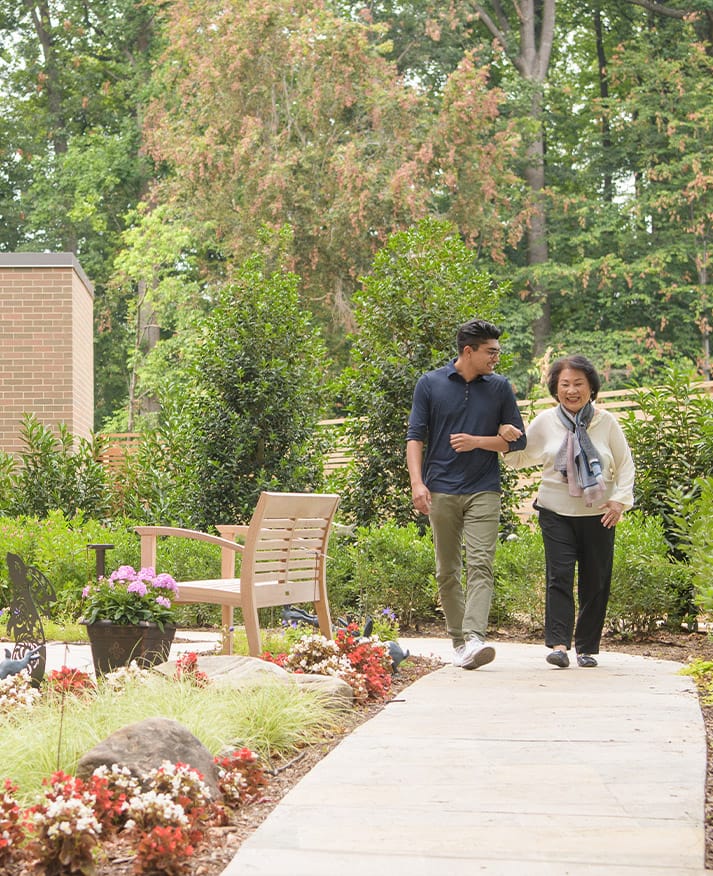Is It Time To Consider Assisted Living?
Things to keep in mind when considering making a move.
Navigating the decision to transition into assisted living can be challenging but also immensely rewarding. If daily household chores are becoming increasingly burdensome or you’re craving more social interaction, it might be time to consider the benefits of a Watermark assisted living community.
Our assisted living communities are meticulously designed to alleviate the burden of daily tasks. Residents benefit from a less physically demanding lifestyle, which is shown to improve overall health. Engaging social programs, classes, and outings are readily available, enhancing residents’ quality of life by providing opportunities to connect and participate in a vibrant community environment.
Signs It’s Time for Assisted Living
Recognizing when it’s time to consider assisted living is crucial. Key indicators include:
- Difficulties with daily living activities like bathing, dressing, and medication management.
- Increased isolation or loneliness.
- Safety concerns like forgetfulness that could lead to accidents.
Transitioning to an assisted living community can provide the necessary support to address these challenges while maintaining a high quality of life.
Health and Mobility Changes
Changes in health and mobility are significant indicators that assisted living may be the next step. Assisted living communities offer tailored care that adapts to individual health needs, helping manage chronic conditions and mobility limitations in a supportive environment.
Social and Emotional Considerations
The social and emotional well-being of seniors is just as important as physical health. Assisted living communities provide a social atmosphere that combats loneliness and isolation — a common issue among seniors who live alone. Regular social activities contribute to a sense of community and improved mental health, vital for seniors’ overall well-being.
Family Support and Caregiving Dynamics
The role of family in the caregiving process can significantly impact the decision to move to an assisted living facility. As caregiving demands escalate, families may find it challenging to meet the increasing needs of their loved ones due to physical, emotional, or logistical reasons. Caregiver burnout is a genuine concern and can affect the caregiver’s health, thereby impacting the quality of care they can provide.
Assisted living can offer a solution by providing professional care and support, thus relieving family members of the overwhelming responsibilities. It allows them to return to their roles as children, spouses, and relatives, rather than full-time caregivers.
Legal and Health Care Planning
Preparing for a move to an assisted living community isn’t just about physical and emotional preparation; it’s also about ensuring all legal and health care documentation is in order. This preparation includes having up-to-date wills, advance directives, and power of attorney documents.
It’s crucial for residents and their families to discuss and understand the details of health care planning, including how assisted living communities can coordinate with health care providers to manage and streamline residents’ care. This planning ensures that the resident’s medical needs are met promptly and according to their wishes.
Adapting to Life in Assisted Living
Adjusting to life in an assisted living community can take time. New residents and their families need to understand this transition. Communities often have resources and programs to help new residents integrate and feel at home. These include welcome committees, orientation sessions, and buddy systems that pair new residents with longer-term ones. Emotional support during the initial period can be crucial, as it helps new residents overcome feelings of loss or change and embrace the new opportunities and friendships that assisted living offers.
Quantifying the Benefits of Assisted Living
The substantial increase in the senior population and the corresponding need for nearly one million additional assisted living residences over the next few decades highlight the growing demand for such facilities. This demand is fueled by the aging baby boomer generation, whose preferences are shaping the future of senior living toward more person-centered care.
Studies indicate that assisted living community residents experience notable improvements in their health and social engagement. These communities offer crucial support for daily living activities, which become increasingly challenging with age. The structured environment also provides consistent social interaction, which is vital for combating loneliness and maintaining mental health.
Regular engagement in community activities has been linked to better cognitive function and reduced risk of depression among seniors. Here’s a deeper look at these benefits, supported by recent findings:
- Social Engagement and Mental Health: Social engagement in assisted living facilities significantly improves older adults’ physical and cognitive health. These settings offer regular social activities that have been shown to enhance mental health and overall well-being, which are crucial for seniors’ quality of life.
- Personalized Care and Independence: Assisted living provides a balance of independence and personalized care, helping with daily activities like bathing, dressing, and medication management. This support allows seniors to maintain some autonomy in a safe environment. Here, physical and occupational therapies, often covered by Medicare, are available to enhance their quality of life.
- Economic Viability: While the cost of assisted living can vary, it generally presents a more affordable alternative to nursing home care. The structured environment and the services provided make it a feasible option for many families considering long-term care solutions for their aging loved ones.
Each of these points underlines the crucial role assisted living plays in enhancing the lives of seniors by providing necessary care, social opportunities, and a supportive community environment.
What To Expect When Transitioning Into an Assisted Living Community
Transitioning to assisted living is a significant change. Seniors and their families need to understand what to expect and how to prepare. That includes understanding the types of activities available, the level of care provided, and how to personalize one’s living space to feel like home.
At Watermark Retirement Communities, we offer Independent Living, Assisted Living, and Memory Care communities nationwide. Our associates are committed to helping you or your loved ones determine when a move might be beneficial.
For more detailed insights and to discuss your assisted living options, contact one of our trusted associates today. We are dedicated to making the decision-making process smoother and ensuring you are well-informed every step of the way.
At Watermark, our residents lead enriching and rewarding lives with confidence. Enjoy total peace of mind knowing that expert care is always just a moment away, allowing you to focus on the things that matter most to you.


